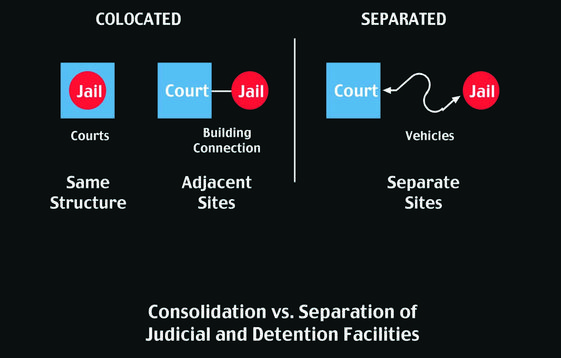Consolidation or Separation of Judicial and Detention Facilities
Arguments in favor of co-locating such facilities related to the secure and economical transportation of in-custody defendants. Direct access between correctional and judicial facilities (such as through a connecting tunnel) lessens the threat of escape during transport from jail to court. Such escapes are rare, but the threat exists. More important, direct access reduces operational costs of transportation, particularly vehicular costs. Staff costs frequently are offset regardless of consolidation or separation, depending on the distances involved, because a similar number of custody personnel may be employed to move groups of defendants either through tunnels or in vehicles. Security personnel will typically move prisoners in fairly small and controllable groups, whether on foot or in vans. Excessive travel time may help determine relative staffing costs, but where long distances-ten to fifteen miles-are not involved, amortized operating costs of vehicles may give the truest picture of relative economies of operation.
 |
The rapid and convenient access to defendants in custody by attorneys, public defenders, and other court personnel is sometimes cited as an additional advantage of co-location. The typical modern court house, however, should have internal holding capabilities to enable convenient court access to detainees throughout the court day. Defendants in custody are transported in groups from the detention facility (whether physically linked or not) to a central holding and staging area inside the courthouse and then dispersed to the individual courtrooms as needed. The real access issue involves those special instances when individual detainees must be brought from the jail on very short notice. Distance and frequency of occurrence must be evaluated in assessing the relative importance of this issue.
Arguments against co-location of judicial and detention facilities fall into two categories: philosophical and facility-related.
Philosophical Objections
Detention facilities compromise the image of justice and the general presumption of innocence.
Facility-related Objections
Space and location needs of court and detention facilities are generally different. Efficiently operating courthouses tend to be vertical. Functions are stacked with multiple vertical circulation systems serving the various floors. While vertical detention facilities are more efficient for the same reasons that make vertical courthouses more efficient, downtown high-rise jails may be more expensive, because a downtown location often means more attention to the facade. As the jail population increases beyond what is considered reasonable for a downtown setting, the tendency is to expand to multiple facilities containing large kitchen and laundry facilities, which are more easily accommodated at a suburban location. The need for outdoor recreation and the desirability of establishing a perimeter also make a suburban setting desirable.
The second facility-related difficulty involves predictable growth and expansion. Generally speaking, judicial facilities grow in response to increasing demands for judicial services, which are quantifiable in terms of increasing caseloads. The growth in the demand for detention facilities, however, is less predictable, because there are typically so many potential detainees that all available bed spaces will be filled regardless of how quickly new detention facilities are built. Consequently, while jurisdictions may be able to use centralized judicial facilities for many decades, detention facilities may exert expansion pressures every few years. As jurisdictions consider co-location, they should weigh the difficulty of having two facilities, with different physical requirements, growing at different rates and for different reasons, side-by-side and physically connected. As with the consolidation of judicial facilities, particular circumstances may encourage particular solutions, but careful consideration of both short- and long-term advantages and disadvantages should precede a final decision.
One way communities have found to get around this problem is to install remote video equipment for conducting arraignments and other preliminary hearings without having to transport prisoners from the jail to the courthouse. Video arraignment has a number of advantages, including:
- Reduced Inmate Processing. It takes considerable time to get prisoners ready to be transported to court in the morning. This involves hours of personnel time in preparing and processing paperwork. Reducing the number of prisoners that must be readied each morning for court saves considerable staff time.
- Enhanced Court Security. There are always considerable security concerns when transporting prisoners to and from court both on public streets and at the point of transfer at the courthouse. Moving fewer prisoners daily means fewer risks to the public.
- Reduced Transportation Costs. The cost of transporting prisoners to court and back to jail is considerable. It includes the time spent by drivers and guards and the cost of purchasing, or renting, and operating transport vehicles. In a large court system, this can be a considerable expense.
- Reduced Need for Holding Cells. With fewer prisoners being brought to the courthouse each day, the size of central holding areas, and holding areas adjacent to courtrooms, may be reduced.